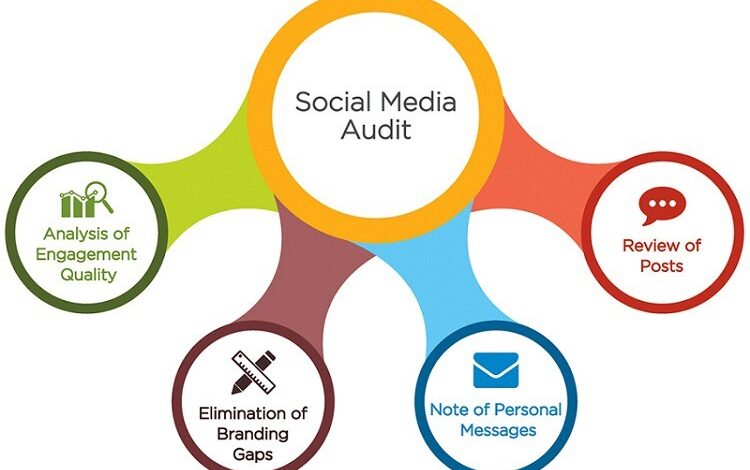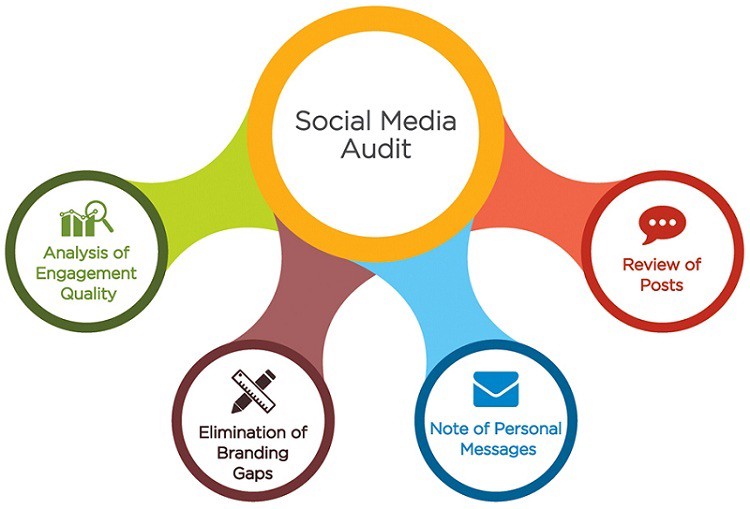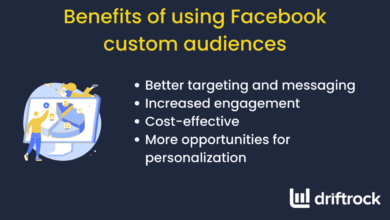
Social Media Audit A Deep Dive
Social media audit is crucial for understanding your online presence. It’s a systematic evaluation of your social media performance across various platforms, analyzing content strategies, community management, and overall effectiveness. This process helps identify strengths and weaknesses, allowing you to optimize your social media strategy for better results. The process is a great way to evaluate the success of your efforts.
This audit delves into defining the audit itself, assessing performance metrics, analyzing content strategies, evaluating community management, identifying areas for improvement, and finally, reporting and action planning. Each stage is critical to a successful social media presence.
Defining a Social Media Audit
A social media audit is a crucial step for any business aiming to leverage social media effectively. It’s a systematic evaluation of your current social media presence, performance, and overall strategy. This process provides a clear picture of your strengths, weaknesses, and opportunities for improvement. It helps you understand what’s working, what’s not, and where you can optimize your efforts to achieve better results.A comprehensive social media audit helps you identify areas where your social media strategy needs adjustment.
This, in turn, leads to more effective use of your resources and better return on investment.
Defining a Social Media Audit
A social media audit is a thorough examination of a company’s social media activities across various platforms. It involves assessing the current state of their presence, evaluating the effectiveness of their strategies, and identifying potential areas for improvement. This process is crucial for businesses looking to maximize their return on investment (ROI) in social media.
Key Objectives of a Social Media Audit
The primary objectives of a social media audit are multifaceted. They encompass understanding the current performance of social media channels, identifying areas needing improvement, and establishing a solid foundation for future growth. Crucially, it pinpoints opportunities for optimization and resource allocation to yield better results.
Importance of a Social Media Audit for Businesses
A social media audit is essential for businesses of all sizes. It provides a clear picture of their social media performance, revealing strengths, weaknesses, and opportunities. This comprehensive analysis allows businesses to make informed decisions, adjust their strategies, and ultimately achieve better results in their social media efforts. It helps align social media activity with overall business goals and provides a benchmark for future performance.
Simple Framework for a Social Media Audit
A well-structured framework for a social media audit helps ensure a comprehensive analysis. This involves systematically evaluating various aspects of your social media presence and establishing a clear direction for improvement. The framework allows for a structured approach, ensuring all crucial elements are considered.
Social Media Audit Table
| Platform | Metrics | Performance | Actionable Insights |
|---|---|---|---|
| Engagement rate, reach, follower growth, website traffic | High engagement but low website traffic | Improve call-to-action in posts to drive more traffic. | |
| Reach, engagement, follower growth, brand mentions | Steady follower growth but low engagement rate | Optimize posting schedule and content formats to enhance engagement. | |
| Engagement rate, reach, follower growth, mentions, trends | High reach but low engagement | Focus on relevant trends and conversations to boost engagement. | |
| Engagement rate, reach, follower growth, lead generation | Low engagement and limited lead generation | Create more valuable content for professionals and run targeted campaigns. |
Assessing Social Media Performance

Understanding your social media performance is crucial for optimizing your strategies and achieving your goals. A thorough assessment reveals areas of strength and weakness, allowing you to refine your approach and maximize your return on investment. This analysis involves identifying key performance indicators (KPIs), measuring engagement, tracking reach, evaluating brand mentions, and assessing advertising effectiveness. By analyzing this data, you can identify trends, understand your audience, and ultimately achieve better results.A social media audit isn’t just a snapshot; it’s a continuous process.
Regular assessments allow you to adapt to evolving trends and maintain a competitive edge in the dynamic social media landscape. This process provides insights into what resonates with your audience and what doesn’t, allowing you to fine-tune your strategy over time.
Key Performance Indicators (KPIs) for Various Social Media Platforms
Different social media platforms have unique characteristics, and thus, different KPIs are relevant for each. A comprehensive assessment considers the specific metrics that matter most for each platform. These metrics provide valuable insights into the effectiveness of your strategy.
- Facebook: Focus on likes, shares, comments, reach, and website clicks. Page likes and engagement rates are vital indicators of community growth and interaction.
- Instagram: Engagement metrics such as likes, comments, saves, and shares are important. Consider follower growth, impressions, and the reach of your posts to understand audience engagement.
- Twitter: Track retweets, replies, likes, and impressions to assess engagement and brand awareness. The volume of mentions and sentiment analysis are also crucial indicators of brand perception.
- LinkedIn: Focus on engagement metrics like comments, shares, and reactions. Professional connections, content downloads, and lead generation are also key indicators of success on LinkedIn.
Measuring Engagement Metrics
Engagement metrics are crucial for gauging how well your content resonates with your target audience. These metrics provide valuable insights into content effectiveness.
- Likes, Comments, and Shares: Track the number of likes, comments, and shares to understand audience response to your posts. A high volume indicates interest and engagement.
- Click-Through Rates (CTR): Monitor CTRs from social media posts to website landing pages. A higher CTR suggests effective calls to action and compelling content.
- Average Engagement Rate: Calculate the average engagement rate across all your posts. This metric provides a holistic view of your audience’s engagement with your content.
Tracking Reach and Impressions, Social media audit
Understanding reach and impressions is essential for assessing the visibility of your content. These metrics help you gauge the overall exposure of your posts and brand.
- Reach: Track the number of unique users who saw your posts. This metric indicates the potential audience impacted by your content.
- Impressions: Monitor the total number of times your posts were displayed. This metric reflects the overall visibility of your content, even if a user didn’t interact with it.
- Frequency: The number of times an individual user sees your content. High frequency suggests strong visibility, but can also indicate repetitive content.
Evaluating Brand Mentions and Sentiment Analysis
Brand mentions and sentiment analysis provide insights into how your brand is perceived in the digital space. Monitoring these elements provides crucial feedback.
- Brand Mentions: Track mentions of your brand name, product, or services across social media. This reveals brand awareness and potential conversations.
- Sentiment Analysis: Analyze the tone and sentiment of brand mentions. Is the sentiment positive, negative, or neutral? Negative mentions should be addressed to mitigate potential damage.
- Brand Monitoring Tools: Use specialized tools to automatically track brand mentions and analyze sentiment. This saves time and provides valuable data insights.
Assessing Social Media Advertising Campaigns
Analyzing the effectiveness of your social media advertising campaigns is essential for optimizing ad spend and achieving desired outcomes. Campaign analysis involves evaluating various metrics.
- Return on Ad Spend (ROAS): Measure the return on investment from your advertising campaigns. A high ROAS indicates effective ad strategies.
- Conversion Rates: Track the conversion rates from social media ads to desired actions (e.g., purchases, sign-ups). This demonstrates the effectiveness of your ads in driving conversions.
- Cost per Acquisition (CPA): Calculate the cost required to acquire a customer through social media advertising. This helps you understand the efficiency of your ad spend.
KPI Comparison Table
| KPI | Importance | ||||
|---|---|---|---|---|---|
| Reach | High | Medium | Medium | Medium | Brand Awareness |
| Engagement (Likes/Comments/Shares) | High | High | Medium | Medium | Audience Interaction |
| Impressions | High | Medium | High | Medium | Content Visibility |
| Website Clicks | High | Medium | Medium | Medium | Lead Generation |
| Brand Mentions | High | Medium | High | Medium | Brand Perception |
Analyzing Content Strategies
Understanding your social media content’s performance is crucial for optimizing your strategy and achieving your goals. A deep dive into content analysis reveals patterns, identifies what resonates with your audience, and pinpoints areas for improvement. This crucial step allows you to tailor your approach, boosting engagement and ultimately, driving results.Content analysis isn’t just about counting likes and shares; it’s about understanding the underlying reasons behind those metrics.
This involves examining various factors, from the type of content you create to the platforms you use. By carefully studying your content’s performance, you can identify trends, optimize your approach, and build a stronger social media presence.
Strategies for Analyzing Content Performance
A comprehensive analysis of content performance requires a multifaceted approach. This includes tracking key metrics like engagement rates, reach, and click-through rates. Furthermore, scrutinizing audience interactions, such as comments and shares, provides valuable insights into content reception.
Identifying Successful and Unsuccessful Content
Successful content consistently garners high engagement, leading to increased reach and brand awareness. Conversely, unsuccessful content often exhibits low engagement, limited reach, and a lack of audience interaction. The key to identifying these patterns lies in consistent monitoring and evaluation. Analyzing content performance data across various platforms allows you to pinpoint specific content formats or topics that resonate most strongly with your target audience.
Identifying Content Trends on Different Platforms
Understanding platform-specific content trends is essential for maximizing your impact. Each platform has unique characteristics, influencing the type of content that performs best. For instance, short-form video content often thrives on platforms like TikTok and Instagram Reels, while longer-form articles and in-depth discussions may excel on LinkedIn or Twitter. Keeping a pulse on emerging trends within each platform allows for alignment with current preferences.
Comparing Content Formats that Perform Well on Various Platforms
Different content formats yield varying results on different platforms. Visual content, including images and videos, typically performs well across most platforms. However, the specific format and length that resonate best can vary significantly. For example, Instagram Stories often benefit from visually engaging content with short, impactful messages, whereas longer-form videos may perform better on YouTube or Facebook.
Best Practices for Creating a Content Calendar for Social Media
A well-structured content calendar is vital for consistent posting and optimal engagement. It should Artikel content themes, topics, and posting schedules across different platforms. The calendar should align with your overall marketing strategy, ensuring a cohesive brand message and consistent posting frequency. Planning content in advance enables efficient management and facilitates a more strategic approach to social media engagement.
Consider incorporating a variety of content formats to maintain audience interest and avoid monotony.
Table of Best Content Formats and Platforms for Optimal Engagement
| Platform | Best Content Formats | Examples |
|---|---|---|
| High-quality photos, short videos, Stories, Reels | Product showcases, behind-the-scenes glimpses, user-generated content | |
| TikTok | Short-form videos, trending challenges, comedic content | Dance trends, educational content, lip-sync videos |
| Engaging posts, articles, videos, live streams | Company announcements, community updates, Q&A sessions | |
| Short, concise posts, trending topics, engaging questions | News updates, thought leadership, industry insights | |
| Articles, long-form content, industry news, thought leadership | Expert opinions, company updates, professional insights | |
| YouTube | Videos, tutorials, product demonstrations, interviews | Product reviews, how-to guides, behind-the-scenes content |
Evaluating Community Management
Community management is the lifeblood of a thriving social media presence. It’s more than just posting content; it’s about fostering relationships, understanding audience needs, and ensuring a positive brand experience. A robust community management strategy is crucial for identifying areas for improvement, and this evaluation process is vital for maintaining a healthy and engaged online community.A thorough evaluation of community management goes beyond simply monitoring likes and shares.
It delves into the depth of engagement, the responsiveness of the team, and the overall brand perception. This comprehensive approach allows for strategic adjustments to enhance the social media experience and maximize its potential.
Analyzing Community Engagement
Understanding the level of engagement within your social media communities is essential for tailoring your strategy. Engagement encompasses various interactions, including comments, shares, messages, and mentions. A comprehensive analysis looks at the frequency and type of engagement to identify patterns and areas needing attention. Monitoring the sentiment expressed in these interactions is crucial to gauge audience response and adjust your content strategy accordingly.
A social media audit is crucial for understanding your online presence. It helps you identify what’s working and what’s not, and where you can improve. One key area to investigate is Facebook ad targeting options, like the precision advertising strategies discussed in this helpful resource: facebook ad targeting options precision advertising. This deeper dive into your Facebook campaigns can really fine-tune your strategy and improve ROI.
Ultimately, a comprehensive social media audit will help you optimize all your social media channels.
Measuring Social Media Team Responsiveness
Team responsiveness is a critical component of community management. A responsive team addresses inquiries promptly, manages concerns effectively, and fosters a sense of connection with the audience. This can be measured through metrics like average response time to comments and messages, and the resolution rate for issues raised. Tracking these metrics provides valuable insights into the efficiency and effectiveness of the social media team’s performance.
For example, a slow response time to customer inquiries can lead to frustrated customers and a negative brand image.
Measuring Brand Perception
Brand perception is shaped by the collective experience of interacting with your brand on social media. This is assessed by analyzing comments and feedback, both positive and negative. Tools that track sentiment analysis can help quantify the overall tone of conversations. A significant volume of negative comments may indicate a need for addressing specific issues or refining your communication strategy.
Tools that provide an overview of user sentiment can help measure the brand perception based on public discussions.
Managing Negative Comments
Negative comments, while sometimes challenging, are opportunities for improvement. Addressing them constructively can transform a potential crisis into a chance to showcase transparency and customer service. The key is to acknowledge the concern, respond professionally, and strive to resolve the issue. This demonstrates empathy and a commitment to addressing user concerns. Never delete negative comments without a valid reason.
Creating a Social Media Style Guide
A social media style guide is a critical document for maintaining brand consistency across all platforms. It establishes clear guidelines for tone, language, image usage, and brand voice. This guide serves as a reference for all social media team members and ensures a unified brand experience. A well-defined style guide can help avoid inconsistencies and ensure a clear, professional presence across all channels.
A style guide should also include brand values, target audience, and platform-specific guidelines.
Comparing Active and Inactive Communities
This table illustrates key characteristics of active and inactive social media communities across various platforms. Understanding these differences allows for strategic adjustments to foster engagement and growth.
| Characteristic | Active Community | Inactive Community |
|---|---|---|
| Engagement Rate | High (e.g., frequent comments, shares, messages) | Low (e.g., infrequent or no engagement) |
| Response Time | Prompt (e.g., within hours or minutes) | Slow (e.g., days or weeks) |
| Content Interaction | High interest in posted content (e.g., likes, comments) | Low interest in posted content (e.g., few likes, comments) |
| Platform | Engaged across various platforms | Engaged on a limited set of platforms |
| Content Quality | High-quality, engaging content that aligns with audience interests | Low-quality or irrelevant content |
Identifying Areas for Improvement

A social media audit isn’t just about cataloging your current performance; it’s a crucial step towards building a stronger online presence. Identifying areas needing improvement is the bridge between understanding your current state and creating a roadmap for future success. This involves a critical look at your strengths and weaknesses, and then strategically prioritizing those areas for attention.Pinpointing weaknesses isn’t about dwelling on failures, but rather about objectively assessing where your strategy could be more effective.
This process allows for a proactive approach, allowing you to address issues before they significantly impact your social media goals.
So, you’re ready to dive into a social media audit? Before you get overwhelmed, consider these 10 social media tips for small businesses to save time here. Knowing how to schedule posts, repurpose content, and track your results efficiently will make your audit much smoother. Ultimately, a well-planned social media audit is key to understanding your audience and optimizing your strategy for better engagement and ROI.
Identifying Weaknesses Based on the Audit
The audit results provide a comprehensive overview of your social media performance. Analyzing metrics like engagement rates, follower growth, website traffic, and content reach will reveal areas where your strategy may be falling short. A clear understanding of what’s not working is the first step in creating a plan for improvement. For example, low engagement rates might indicate a need for more interactive content or a mismatch between your content and your target audience’s interests.
Prioritizing Areas for Improvement
Prioritization is essential to focus your efforts effectively. Consider the potential impact of each weakness on your overall goals. For example, if your content strategy is failing to resonate with your target audience, this may have a larger impact on your bottom line than a minor issue with community management. Consider factors like the severity of the issue, its potential impact on key metrics, and the resources required to address it.
Developing a Plan to Address Identified Issues
Once you’ve prioritized areas for improvement, you need a structured approach to create actionable solutions. This plan should be detailed and include specific strategies, timelines, and measurable goals. A critical component of the plan is defining specific, measurable, achievable, relevant, and time-bound (SMART) goals.
A social media audit is crucial for any organization, but especially for nonprofits looking to boost their fundraising efforts. Understanding your current social media presence is key, and often, that means finding the right help. Partnering with a dedicated agency, like social media management agencies for nonprofit fundraising , can help you craft a strategy that leverages your existing audience and platforms to reach more potential donors.
This data-driven approach, combined with a thorough audit, is the best way to maximize your online impact.
Actionable Strategies
Here are examples of actionable strategies for addressing weaknesses in content, community, or performance:
- Content Strategy Weakness: Low engagement on posts.
Solution: Introduce more interactive content formats like polls, quizzes, and Q&A sessions. A/B test different types of content to determine what resonates best with your audience.
- Community Management Weakness: Lack of response to comments and messages.
Solution: Establish a clear response time policy and ensure that dedicated staff members are available to respond promptly to interactions. Consider using social media management tools to streamline communication.
- Performance Weakness: Low website traffic from social media.
Solution: Create engaging calls to action (CTAs) in your social media posts that encourage clicks to your website. Optimize your social media posts with relevant hashtags and s to improve discoverability.
Creating Measurable Goals for Improvement
Measurable goals are critical for tracking progress and demonstrating the effectiveness of your efforts. Quantify your goals, for example, “Increase Instagram engagement by 20% within the next quarter.” This ensures that you have clear benchmarks for success. Establish clear metrics to track progress, such as the number of comments, shares, likes, or website clicks generated from your social media posts.
Plan for Addressing Weaknesses
| Problem | Solution | Timeline | Metrics |
|---|---|---|---|
| Low engagement on Instagram posts | Implement interactive content (polls, quizzes) and A/B test different content formats. | Q3 2024 | Increase engagement rate by 20%, measured by likes, comments, shares, and saves. |
| Slow response times to comments | Allocate dedicated time slots for social media engagement and use social media management tools. | Q3 2024 | Reduce average response time to comments by 50%, measured by the time taken to reply. |
| Low website traffic from social media | Implement clear calls to action (CTAs) in posts and optimize posts with relevant hashtags and s. | Q3 2024 | Increase website traffic from social media by 15%, measured by website analytics. |
Reporting and Action Planning: Social Media Audit
A social media audit isn’t complete without a clear roadmap for implementation. This crucial phase transforms findings into actionable strategies, ensuring stakeholders understand the audit’s implications and the steps needed to improve performance. Thorough reporting and a well-defined action plan are key to achieving desired outcomes.The report should be more than just a collection of data points; it should be a compelling narrative that showcases opportunities for growth and improvement.
This phase requires a structured approach to presenting findings and translating them into concrete, measurable actions.
Creating a Comprehensive Report
A comprehensive social media audit report should be organized to provide a clear overview of the audit’s findings. It should start with an executive summary, followed by detailed sections on performance assessment, content analysis, community management, and areas for improvement. Each section should include supporting data, visuals, and examples to strengthen the analysis and recommendations. Include specific metrics, such as engagement rates, reach, follower growth, and website traffic, where possible.
Presenting the Report to Stakeholders
The presentation of the social media audit report should be tailored to the specific audience. For executives, a concise executive summary with key takeaways and recommendations is crucial. For marketing teams, a more detailed breakdown of each section is necessary, enabling them to understand the context and implications of the findings. Visual aids, such as charts and graphs, can enhance understanding and engagement.
Use clear and concise language, avoiding jargon. A Q&A session at the end allows for clarification and discussion.
Incorporating Recommendations for Improvement
Recommendations for improvement should be directly tied to the identified areas for concern. For example, if low engagement is a problem, the report should propose specific strategies to increase it. These recommendations should be actionable and measurable. Include suggested tools, resources, and training to support implementation. Frame recommendations positively, highlighting potential benefits and returns on investment.
This fosters a proactive approach to problem-solving.
Developing Actionable Steps for Implementation
Turning recommendations into actionable steps requires a structured approach. Break down each recommendation into specific, measurable, achievable, relevant, and time-bound (SMART) goals. Assign responsibilities to specific individuals or teams. Establish clear timelines for each step. This provides a roadmap for implementation, ensuring that recommendations are not just suggestions, but tangible actions.
Consider creating a project plan or Gantt chart to visually represent the steps and deadlines.
Executive Summary Template
| Section | Content |
|---|---|
| Introduction | Briefly state the purpose of the social media audit and the scope of the analysis. |
| Key Findings | Summarize the most important observations from the audit, focusing on strengths, weaknesses, and opportunities. |
| Performance Assessment | Highlight key performance indicators (KPIs) and their trends. Include relevant metrics, such as engagement rate, reach, and follower growth. |
| Content Analysis | Summarize the quality and effectiveness of existing content, identifying areas for improvement. |
| Community Management | Evaluate the effectiveness of community management strategies and suggest improvements for building a stronger online presence. |
| Areas for Improvement | Identify specific areas needing attention, such as content strategy, community engagement, or platform optimization. |
| Recommendations | Provide clear and actionable recommendations for improvement, outlining the steps to implement them. |
| Next Steps | Artikel the next steps, timelines, and responsibilities for implementing the recommendations. |
Social Media Audit Flowchart

The flowchart visually represents the sequence of steps from initial planning to the final presentation of the report. It clearly illustrates the progression and dependencies between each phase of the audit process.
Final Review
In conclusion, a comprehensive social media audit is an essential step for any business or individual looking to maximize their online impact. By meticulously evaluating all aspects of your social media strategy, you can pinpoint areas for improvement and create a plan for future success. This meticulous process provides actionable insights and helps you tailor your strategy for better results.




